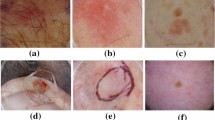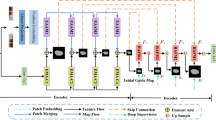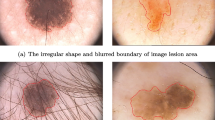Abstract
Skin lesion segmentation is an important process in skin diagnosis, but still a challenging problem due to the variety of shapes, colours, and boundaries of melanoma. In this paper, we propose a novel and efficient U-shaped network named EAM-CPFNet, which combines with edge attention module (EAM) and context pyramid fusion (CPF) to improve the performance of the skin lesion segmentation. First, we design a plug-and-play module named edge attention module (EAM), which is used to highlight the edge information learned in the encoder. Secondly, we integrate two pyramid modules collectively named context pyramid fusion (CPF) for context information fusion. One is multiple global pyramid guidance (GPG) modules, which replace the skip connections between the encoder and the decoder to capture global context information, and the other is scale-aware pyramid fusion (SAPF) module, which is designed to dynamically fuse multi-scale context information in high-level features by utilizing spatial and channel attention mechanisms. Furthermore, we introduce full-scale skip connections to enhance different levels of global context information. We evaluate the proposed method on the publicly available ISIC2018 dataset, and the experimental results demonstrate that our proposed method is very competitive compared with other state-of-the-art methods for the skin lesion segmentation.
Graphical abstract








Similar content being viewed by others
References
Siegel RL, Miller KD (2018) Jemal A (2018) Cancer statistics. CA Cancer J Clin 60(Suppl 12):277–300
Zanddizari H, Nguyen N, Zeinali B, Chang JM (2021) A new preprocessing approach to improve the performance of CNN-based skin lesion classification. Med Biol Eng Compu 59(5):1123–1131
Balch CM, Gershenwald JE, Soong SJ, Thompson JF et al (2009) Final version of 2009 AJCC melanoma staging and classification. J Clin Oncol 27(36):6199–6206
Huang S, Lee FF, Miao R, Si Q, Lu CW, Chen Q (2020) A deep convolutional neural network architecture for interstitial lung disease pattern classification. Med Biol Eng Compu 58(4):725–737
Wu H, Pan J, Li Z, Wen Z, Qin J (2021) Automated skin lesion segmentation via an adaptive dual attention module. IEEE Trans Med Imag 40(1):357–370
Sez A, Serrano C, Acha B (2014) Model-based classification methods of global patterns in dermoscopic images. IEEE Trans Med Imag 33(5):1137–1147
Hu K, Liu S, Zhang Y, Cao C, Xiao F, Huang W, Gao X (2020) Automatic segmentation of dermoscopy images using saliency combined with adaptive thresholding based on wavelet transform. Multimed Tools Appl 79(21–22):14625–145642
Khadidos A Sanchez V Li C (2014) Active contours based on weighted gradient vector flow and balloon forces for medical image segmentation. In: IEEE International Conference on Image Processing, pp 902–906
Long J Shelhamer E Darrell T (2015) Fully convolutional networks for semantic segmentation. In: Proc IEEE Conf Comput Vis Pattern Recognit, pp 3431–3440
Ronneberger O Fischer P Brox T (2015) U-net: Convolutional networks for biomedical image segmentation. In: International conference on medical image computing and computer-assisted intervention, Springer, pp 234–241
Dash M, Londhe ND, Ghosh S, Semwal A, Sonawane RS (2019) Pslsnet: Automated psoriasis skin lesion segmentation using modified u-net-based fully convolutional network. Biomed Signal Process Control 52:226–237
Lbtehaz N, Rahman MS (2020) MultiResUNet: Rethinking the U-Net architecture for multimodal biomedical image segmentation. Neural Netw 121:74–87
Szegedy C Liu W Jia Y Sermanet P et al. (2015) Going deeper with convolutions. In: Proc IEEE Conf Comput Vis Pattern Recognit, pp 1–9
Oktay O Schlemper J Folgoc LL Lee MCH et al. (2018) Attention U-Net: learning where to look for the pancreas. arXiv:1804.03999
Arora R, Raman B, Nayyar K, Awasthi R (2021) Automated skin lesion segmentation using attention-based deep convolutional neural network. Biomed Signal Process Control 65:102358
Zhang J, Xie Y, Xia Y, Shen C (2019) Attention residual learning for skin lesion classification. IEEE Trans Med Imag 38(9):2092–2103
Badrinarayanan V, Kendall A, Cipolla R (2017) SegNet: A deep convolutional encoder-decoder architecture for image segmentation. IEEE Trans Pattern Anal Mach Intell 39(12):2481–2495
Pohlen T Hermans A Mathias M Leibe B (2017) Full-resolution residual networks for semantic segmentation in street scenes. In: Proc IEEE Conf Comput Vis Pattern Recognit, pp 4151–4160
Milletari F Navab N Ahmadi SA (2016) V-net: Fully convolutional neural networks for volumetric medical image segmentation. In: Fourth International Conference on 3D Vision, pp 565–571
Çiçek Ö Abdulkadir A Lienkamp SS Brox T Ronneberger O (2016) 3D u-net: learning dense volumetric segmentation from sparse annotation. In: International conference on medical image computing and computer-assisted intervention, Springer, pp 424–432
Alom MZ Hasan M Yakopcic C Taha TM Asari VK (2018) Recurrent residual convolutional neural network based on u-net (r2u-net) for medical image segmentation. arXiv:1804.03999
Pawan SJ, Sankar R, Jain A et al (2021) Capsule network–based architectures for the segmentation of sub-retinal serous fluid in optical coherence tomography images of central serous chorioretinopathy. Med Biol Eng Compu 59(6):1245–1259
Zhou Z Siddiquee MMR Tajbakhsh N Liang J (2018) Unet++: A nested u-net architecture for medical image segmentation. In Deep learning in medical image analysis and multimodal learning for clinical decision support, Springer, 3–11
Geirhos R Rubisch P Michaelis C Bethge M Wichmann FA Brendel W (2019) ImageNet-trained CNNs are biased towards texture; increasing shape bias improves accuracy and robustness. In: International Conference on Learning Representations
Kamnitsas K, Ledig C, Newcombe VF, Simpson JP et al (2017) Efficient multi-scale 3D CNN with fully connected CRF for accurate brain lesion segmentation. Med Imag Anal 36:61–78
Hatamizadeh A Terzopoulos D Myronenko A (2020) Edge-gated CNNs for volumetric semantic segmentation of medical images. arXiv:1804.03999
Sun J Darbehani F Zaidi M Wang B (2020) SAUNet: shape attentive U-Net for interpretable medical image segmentation. In: International conference on medical image computing and computer-assisted intervention, Springer, 797–806
Zhang Z Fu H Dai H Shen J Pang Y Shao L (2019) ET-Net: A generic edge-attention guidance network for medical image segmentation. In: International conference on medical image computing and computer-assisted intervention, Springer, 442–450
Vaswani A Shazeer N Parmar N Uszkoreit J et al. (2017) Attention is all you need. In: Proc Adv Neural Inf Process Syst, 6000–6010
Huang G, Zhu J, Li J, Wang Z et al (2020) Channel-attention U-Net: channel attention mechanism for semantic segmentation of esophagus and esophageal cancer. IEEE Access 8:122798–122810
He K Zhang X Ren S Sun J (2016) Deep residual learning for image recognition. In: Proc IEEE Conf Comput Vis Pattern Recognit, 770–778
Huang G Liu Z Laurens VDM Weinberger KQ (2017) Densely connected convolutional networks. In: Proc IEEE Conf Comput Vis Pattern Recognit, 4700–4708
Guan S, Khan A, Sikdar S, Chitnis PV (2020) Fully dense UNet for 2D sparse photoacoustic tomography artifact removal. IEEE J Biomed Health Informat 24(2):568–576
Zhu Z Xu M Bai S Huang T Bai X (2019) Asymmetric non-local neural networks for semantic segmentation. In Proc IEEE Int Conf Comput Vis, 593–602
Feng S, Zhao H, Shi F, Cheng X et al (2020) CPFNet: Context pyramid fusion network for medical image segmentation. IEEE Trans Med Imag 39(10):3008–3018
Woo S Park J Lee JY Kweon IS (2018) Cbam: convolutional block attention module. In Proc Eur Conf Comput Vis, 3–19
Paszke A Gross S Chintala S Chanan G Yang E DeVito Z Lin Z Desmaison A Antiga L Lerer A (2017) Automatic differentiation in pytorch. In NIPS Workshop
Codella NCF Gutman D Celebi ME Helba B et al. (2018) Skin lesion analysis toward melanoma detection: a challenge at the 2017 International symposium on biomedical imaging (ISBI), hosted by the international skin imaging collaboration (ISIC). In: 2018 IEEE 15th Int Symp Biomed Imag, 168–172
Tschandl P, Rosendahl C, Kittler H (2018) The HAM10000 dataset, a large collection of multi-source dermatoscopic images of common pigmented skin lesions. Sci Data 5:180161
Codella N Rotemberg V Tschandl P Celebi ME et al. (2019) Skin lesion analysis toward melanoma detection 2018: a challenge hosted by the international skin imaging collaboration (ISIC). arXiv:1902.03368
Wu H Zhang J Huang K Liang K Yu Y (2019) FastFCN: rethinking dilated convolution in the backbone for semantic segmentation. arXiv:1902.03368
Gu Z, Cheng J, Fu H, Zhou K et al (2019) CE-Net: context encoder network for 2D medical image segmentation. IEEE Trans Med Imag 38(10):2281–2292
Peng C Zhang X Yu G Luo G Sun J (2017) Large kernel matters- Improve semantic segmentation by global convolutional network. In: Proc IEEE Conf Comput Vis Pattern Recognit, 4353–4361
Yu C Wang J Peng C Gao C Yu G Sang N (2018) Learning a discriminative feature network for semantic segmentation. In: Proc IEEE Conf Comput Vis Pattern Recognit, 1857–1866
Altaf F, Islam SMS, Akhtar N, Janjua NK (2019) Going deep in medical image analysis: concepts, methods, challenges and future directions. IEEE Access 7:99540–99572
Jha D Riegler MA Johansen D Halvorsen P Johansen HD (2020) DoubleU-Net: a deep convolutional neural network for medical image segmentation. In: 2020 IEEE 33rd International Symposium on Computer-Based Medical System, 558–564
Sarker MMK Rashwan HA Akram F Banu SF et al. (2018) Slsdeep: skin lesion segmentation based on dilated residual and pyramid pooling networks. In: International conference on medical image computing and computer-assisted intervention, Springer, 21–29
Chen LC Zhu Y Papandreou G Schroff F Adam H (2018) Encoder-decoder with atrous separable convolution for semantic image segmenstation. In Proc Eur Conf Comput Vis, 801–818
Park J Woo S Lee JY Kweon IS (2018) Bam: bottleneck attention module. arXiv:1807.06514
Fu J Liu J Tian H Li Y Bao Y Fang Z Lu H (2019) Dual attention network for scene segmentation. In: Proc IEEE Conf Comput Vis Pattern Recognit, 3146–3154
Liu L, Ying YT, Mrinal M (2021) Skin lesion segmentation using deep learning with auxiliary task. J Imaging 7(4):67
Yuan Y (2017) Automatic skin lesion segmentation with fully convolutional-deconvolutional networks. arXiv:1703.05165
Al-Masni MA, Al-Antari MA, Choi MT et al (2018) Skin lesion segmentation in dermoscopy images via deep full resolution convolutional networks. Comput Methods Programs Biomed 162:221–231
Zhao H Shi J Qi X Wang X Jia J. (2017) Pyramid scene parsing network. In: Proc IEEE Conf Comput Vis Pattern Recognit, 2881–2890.
Jha D Smedsrud PH Riegler MA Halvorsen P et al. (2020) Kvasir-seg: a segmented polyp dataset. In: International Conference on Multimedia Modeling, Springer, 451–462
Bernal J, Sanchez FJ, Fernandez-Esparrach G, Gil D, Rodrıguez C, Vilarino F (2015) WM-DOVA maps for accurate polyp highlighting in colonoscopy: validation vs. saliency maps from physicians. Comput Med Imag Graph 43:99–111
Jha D Smedsrud PH Riegler MA Johansen D Lange TD Halvorsen P Johansen HD (2019) Resunet++: an advanced architecture for medical image segmentation. In: IEEE International Symposium on Multimedia, 225–2255
Zhang Z, Liu Q, Wang Y (2018) Road extraction by deep residual u-net. IEEE Geosci Remote Sens Lett 15(5):749–753
Author information
Authors and Affiliations
Corresponding authors
Additional information
Publisher's note
Springer Nature remains neutral with regard to jurisdictional claims in published maps and institutional affiliations.
Rights and permissions
About this article
Cite this article
Zuo, B., Lee, F. & Chen, Q. An efficient U-shaped network combined with edge attention module and context pyramid fusion for skin lesion segmentation. Med Biol Eng Comput 60, 1987–2000 (2022). https://doi.org/10.1007/s11517-022-02581-5
Received:
Accepted:
Published:
Issue Date:
DOI: https://doi.org/10.1007/s11517-022-02581-5




